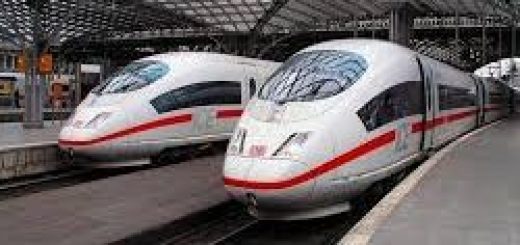New International Train Routes From London: Highly Challenging!
The operators of London St Pancras station and the Channel Tunnel are planning to increase the number of international train routes. But how feasible are these plans?
New international train services from London St Pancras
London St Pancras Highspeed, which owns the station and runs the track to the Channel Tunnel, plans to boost international train capacity from 1,800 to nearly 5,000 passengers per hour.
Together with Getlink, which operates the Channel Tunnel, London St Pancras Highspeed is seeking to increase the number of trains and international destinations from London.
The two parties have signed an agreement to expand rail connectivity between the UK and Europe and are actively seeking train operators to run high-speed services through the Channel Tunnel to London.
A spokesperson of London St Pancras Highspeed said: “Many European cities could be reached directly by train in under six hours which we believe is really competitive with short-haul air travel.”
Possible new operators
Eurostar currently holds a monopoly on international train services from London to Europe, but with its rolling stock stretched thin and the company having limited spare capacity for a major expansion, London St Pancras Highspeed and Getlink are mostly looking for other operators.
Two names frequently mentioned are the Virgin Group and Evolyn, both of which have shown interest in running high-speed trains through the Channel Tunnel.
Virgin stated that international train services from London through the Channel Tunnel are “ripe for change, with plenty of room and potential for new competition at St Pancras and through the Tunnel,” while acknowledging it would be a “huge undertaking”.
According to Getlink CEO Yann Leriche, a “range of new destinations in Germany, Switzerland, and France” should be achievable, with the company highlighting cities such as Bordeaux, Marseille, Cologne, Frankfurt, Geneva, and Zurich as potential new high-speed train destinations from London.

Eurostar trains at London St Pancras. ©AndyBTravels
Newspaper headlines
Unsurprisingly, the plans by Getlink and London St Pancras Highspeed have made headlines in the British media, with almost all newspapers suggesting that new international train services are imminent, while failing to provide the necessary context and analysis.
Some newspapers take this to extremes, with the Daily Mail, for instance, claiming that “Brits could soon get a direct train from London to Milan,” a statement with no factual basis whatsoever.
Sadly, the reality is that British people will not get a direct train from London to Milan anytime soon, and likely never will.

There won’t be any high-speed trains linking London to Milan in the near future. ©AndyBTravels
Challenges
One of the few articles in the British media to provide much-needed context and analysis is this opinion piece in The i Paper by rail expert Jon Worth.
Worth says that even though London St Pancras Highspeed and Getlink want to see more international trains, the first challenge will be determining who exactly will operate these services.
He said: “The problem is that Getlink does not operate the trains: Eurostar does, and its fleet is already spread thin.”
Even if Eurostar can and wants to operate trains to a completely new country, it will face issues.
Worth said: “Eurostar does not own a single train that is compatible with both Channel Tunnel and German safety systems and, likewise, has nothing to serve Zürich in Switzerland.”
According to Worth, it will also take considerable time for new entrants to be in a position to compete with Eurostar.
Worth said: “Virgin Trains and Evolyn both have much-publicised plans to challenge Eurostar on routes from London through the Channel Tunnel, but neither of those companies own any trains, although Virgin says it is close to placing an order for a fleet of 12 units.
“With all the major train manufacturers having backlogs, it is going to be the end of the decade before anything ordered now will even run.”
Passport control
Another major issue for direct rail services between London and the continent is the requirement for passengers travelling to the UK to go through passport control before boarding the train.
Such facilities are currently only available at the stations in London, Brussels, Paris, Lille, Rotterdam, and Amsterdam.
Worth explained: “As passports must be checked, and bags scanned, before passengers board, you cannot run trains to London from any old platform at any station.
“Many of the destinations suggested – Lyon, Marseille, Cologne, Frankfurt, Zürich – do not have any sort of terminal facilities resembling those at St Pancras, Paris Gare du Nord or Bruxelles Midi.
“The UK Government has always refused to look at a different way to solve this problem – to do passport checks on board moving trains, for example.”
Although in theory it would be possible to run a direct train service from, let’s say, London to Munich, as passengers would pass through Schengen immigration at London St Pancras, such a direct service won’t be feasible in the reverse direction.
Unless new European stations are equipped with British immigration facilities, passengers cannot be transported directly to London by train.
A solution could be for trains to stop in Lille, allowing all passengers to disembark with their luggage to pass through customs and immigration checks before being allowed to board again, although this is hardly a passenger-friendly option.
It is therefore highly unlikely that many new destinations across Europe will gain a direct train link to London.
What rail travellers can look forward to in the short term, according to Worth, is that the extra capacity at London St Pancras will lead to a “more pleasant experience at St Pancras – fewer queues, and perhaps even shorter check-in times”.

Eurostar check-in queue at London St Pancras. ©AndyBTravels
Conclusion
London St Pancras International and Getlink aim to increase international train services between London and the European continent.
Although these plans are commendable, it will be many years before rail passengers see the benefits, as Eurostar is currently not in a position to expand, while new entrants will need time to acquire trainsets and establish operations.
Even when a train operator is ready to start new services from London, there are likely to be few new destinations, as European stations would need to set up UK customs and immigration facilities before such connections can be launched.
It’s important not to get your hopes up too high when reading in the newspapers about new train routes from London to a number of appealing European destinations, as chances are that little to none of it will come to fruition.
However, even additional services by new entrants from London to currently served destinations like Brussels, Paris, and Amsterdam would already be a major boost for rail travel, as competition would lower prices and improve service.





